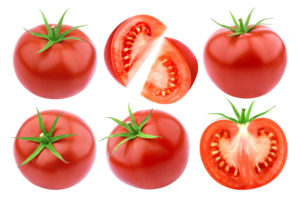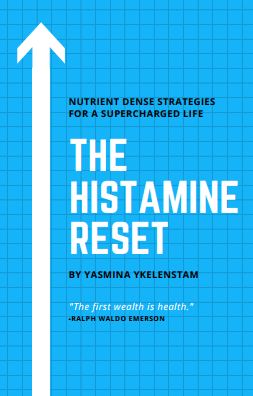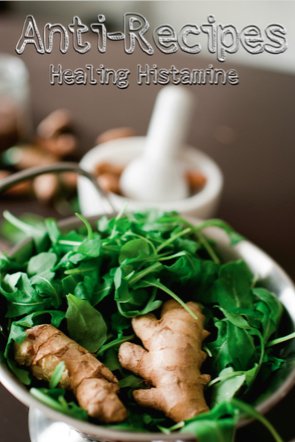
Nitric Oxide (NO). Such an important molecule that it was given “Molecule of the Year” status by the journal Science in 1992, nitric oxide was originally considered a hazardous gas that caused toxic effects in the environment. It was thought to be as harmful inside the body as it is outside the body. But, as with all things histamine intolerance and inflammation-wise, it’s all about balance. While NO is a free radical that can be harmful to the body in high amounts, it also has some extremely vital roles as a signaling molecule in the body — much like histamine. Nitric oxide’s most well-known function is as a vasodilator (expanding blood vessels and promoting good circulation), but it also acts as an immune system regulator, and even as a neurotransmitter.
In dealing with histamine intolerance inflammation, it’s important to look beyond the obvious and dig a little deeper. NO may be an important piece of the histamine puzzle.
THE HISTAMINE-NITRIC OXIDE CONNECTION
When histamine levels become high in the body, nitric oxide is released as a response. And in both animal and human cell studies, nitric oxide was shown to stabilize mast cells and inhibit their release of histamine. Studies also suggest that NO may resolve allergy related inflammation.
So increasing nitric oxide can help calm those mast cells, lower histamine, and lower inflammation.
WHY DO WE HAVE LOW NITRIC OXIDE?
Besides the fact that nitric oxide levels naturally decline with age, a reason behind the NO insufficiency in histamine sufferers may be due to stress hormones, such as cortisol.
Researchers in Mind-Body Medicine discovered that when a person is in the midst of a stress response, nitric oxide release is inhibited by the presence of the stress hormones norepinephrine and cortisol.
Stress is a major enemy of both nitric oxide and nitric oxide synthase, an enzyme that is responsible for the production of nitric oxide from the amino acid, L-arginine.
Since histamine sufferers tend to have chronic inflammation and tend to stay in a chronic state of fight-or-flight, stress hormones stay high and nitric oxide levels stay low.
Additionally, because histamine levels stay elevated for so much of the time, and because nitric oxide is called for each time histamine is released, it can be difficult for the body to keep up with its NO production.
It’s interesting to note that Herbert Benson, M.D. of the Harvard Center for Mind Body Medicine believes that the so-called Placebo Effect may actually be brought about by nitric oxide, as it induces a relaxation response that promotes healing.
So how do we increase Nitric Oxide TO FIGHT HISTAMINE INFLAMMATION?
There are two main pathways for the body to produce NO. One is the nitrate – nitrite – nitric oxide pathway and the other is the citrulline – arginine – nitric oxide – citrulline pathway.
Since nitrates, citrulline, and arginine ultimately raise nitric oxide, consuming foods rich in natural constituents is a good way to raise the body’s levels of NO.
CLICK HERE FOR A FOUR WEEK HISTAMINE RESET WITH MEAL PLANNERS, STRESS RELIEF STRATEGIES & MORE
Nitrate-Rich Foods to Increase NO
Arugula (Best Source)
- Artichoke
- Beets
- Beet Greens
- Bok Choy
- Broccoli
- Cabbage
- Carrots
- Cauliflower
- Celery
- Chinese Cabbage
- Collards
- Lettuce
- Mustard Greens
- Parsley
- Pomegranate
- Rhubarb
- Turnips
- Watercress
Citrulline-Rich Foods to Increase NO
Cucumbers
- Melons
- Watermelon (Best source)
- Winter Squash/Pumpkin
Arginine-Rich Foods to Increase NO
- Chickpeas
- Lentils
- Pumpkin Seeds
- Seafood
- Seaweed
- Spirulina
- Sunflower Seeds
Pycnogenol to Increase NO
A 2007 Swiss study showed that pycnogenol, found in pine nuts, raises nitric oxide.
Vitamin C-rich Foods also increase Nitric Oxide
Broccoli
- Cauliflower
- Kale
- Pomegranate
My new histamine reset is full of the foods listed above, and it comes with a 7 day vegan ultra low histamine planner and a 7 day low salicylate planner.
Lifestyle strategies to Increase NO
Breathing through the nose and not the mouth –25% of nitric oxide in the body is produced by the sinuses. But only when we breathe through the nose. Check out Buteyko Breathing.
- Exercise — (Strength training or aerobic exercise).
- Humming — Has been shown to increase NO up to fifteen fold, as compared to quiet exhalation.
- Red Light Therapy — Increases NO production by the mitochondria (I use Joovv light, use the discount code YASMINA here)
- Scuba diving! — increases NO production, but pressure isn’t great for mast cells
-
CLICK HERE FOR A FOUR WEEK HISTAMINE RESET WITH MEAL PLANNERS, STRESS RELIEF STRATEGIES & MORE
———- REFERENCES ————
Coleman, JW. Nitric oxide: a regulator of mast cell activation and mast cell-mediated inflammation. Clinical and Experimental Immunology. 2002;129(1):4-10. doi:10.1046/j.1365-2249.2002.01918.x.
Dusek, J. A., & Benson, H. (2009). Mind-Body Medicine: A Model of the Comparative Clinical Impact of the Acute Stress and Relaxation Responses. Minnesota Medicine, 92(5), 47–50.
Esch, T, Stefano, GB, Fricchione, GL, Benson, H. Stress-related diseases — a potential role for nitric oxide. Medical Science Monitor, 2002; 8(6): RA103-118.
Koshland, DE. The molecular of the year. Science. 1992; 258(5090): 1861. DOI: 10.1126/science.1470903
Davis, BJ, Flanagan, BF, Gilfillan, AM, Metcalfe, DD, and Coleman, JW. Nitric Oxide Inhibits IgE-Dependent Cytokine Production and Fos and Jun Activation in Mast Cells. Immunology. 2004; 173(11) 6914-6920. DOI:https://doi.org/10.4049/jimmunol.173.11.6914
Green, D. J., Maiorana, A., O’Driscoll, G. and Taylor, R. (2004), Effect of exercise training on endothelium-derived nitric oxide function in humans. The Journal of Physiology, 561: 1–25. doi:10.1113/jphysiol.2004.068197
Hamblin, M. R. (2017). Mechanisms and applications of the anti-inflammatory effects of photobiomodulation. AIMS Biophysics, 4(3), 337–361. http://doi.org/10.3934/biophy.2017.3.337
Maniscalco, M. Sofia, M. Pelaia, G. Nitric oxide in upper airways inflammatory diseases. Inflammation Research. 2007,56(2), 58-69.
Theoharides, T. C., Alysandratos, K.-D., Angelidou, A., Delivanis, D.-A., Sismanopoulos, N., Zhang, B., … Kalogeromitros, D. (2012). Mast cells and inflammation. Biochimica et Biophysica Acta, 1822(1), 21–33. http://doi.org/10.1016/j.bbadis.2010.12.014
Torregrossa, A. C., Aranke, M., & Bryan, N. S. (2011). Nitric oxide and geriatrics: Implications in diagnostics and treatment of the elderly. Journal of Geriatric Cardiology : JGC, 8(4), 230–242. http://doi.org/10.3724/SP.J.1263.2011.00230
Weitzberg, E. Lundberg, J.O. (2002). Humming greatly increases nasal nitric oxide. American Journal of Respiratory Care and Critical Care Medicine, 166(2), 144-145. https://doi.org/10.1164/rccm.200202-138BC
“Scuba diving induces nitric oxide synthesis and the expression of inflammatory and regulatory genes of the immune response in neutrophils.” Physiological Genomics, www.physiology.org/doi/abs/10.1152/physiolgenomics.00028.2014.













